IN THIS ISSUE
- Bridgework spares bat colony
- Bats take over DNR Instagram
- In praise of chipping sparrows
- Swamp thing? Meet the amphiuma
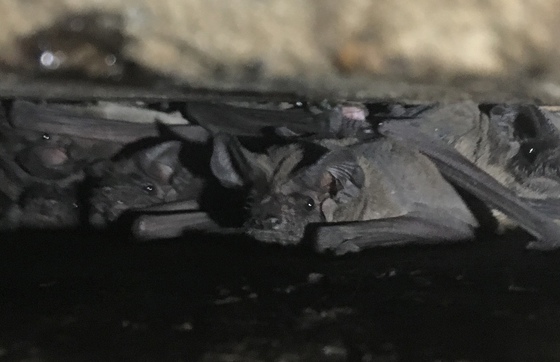 Bats crowd into one of the bridge's expansion joint. (Katrina Morris/DNR)
A busy northwest Georgia bridge and the massive colony of bats that call it home are both better off thanks to recent work that preserved the structure and its wildlife.
The Interstate 75 bridge near Calhoun averages 72,000 vehicles a day. Yet it also doubles as the largest known bridge-roost for bats in the state, according to Katrina Morris, a senior DNR wildlife biologist who leads bat research for the agency’s Wildlife Conservation Section.
“Thousands of big brown and Brazilian free-tailed bats are under the bridge year-round,” using it for shelter, hibernation and raising their young, Morris said.
That combo of interstate infrastructure and protected mammals posed a challenge for the Georgia Department of Transportation: How to complete maintenance – preserving the road surface with a protective coating and replacing expansion joints – while sparing the roost and the bats crowded into the bridge joints underneath?
The answer, suggested DOT Transportation Ecology Special Projects Coordinator Sujai Veeramachaneni, proved efficient and effective.
Learn how DOT and DNR solved this issue for the benefit of people and bats.
Watch the project in action.
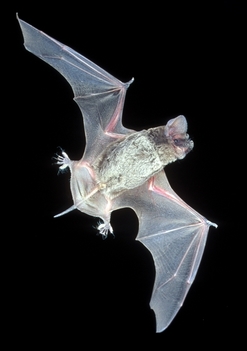 BAT WEEK BEGINS
Georgia Bat Week is on! Proclaimed by Gov. Nathan Deal as Oct. 24-31, Bat Week recognizes the ecological roles that bats play and the threats they face.
Up to 31 percent of North America’s bat species are at risk. Habitat loss and white-nose syndrome are key threats. White-nose is a fast-spreading disease that has killed millions of bats and ravaged populations in north Georgia since it was documented here in 2013.
What can you do to help conserve bats and other wildlife and natural habitats?
Follow the Georgia Bat Working Group to learn about bats and Bat Week events.
BATTY ON INSTAGRAM
Join DNR on Instagram @georgiawildlife for Georgia Bat Week. Bat biologists are taking over to talk all things bats through Halloween.
And don’t miss the Ask A Biologist Q&A session this Monday starting at noon. Just click our logo to submit your question for biologist Laci Pattavina.
Top
|
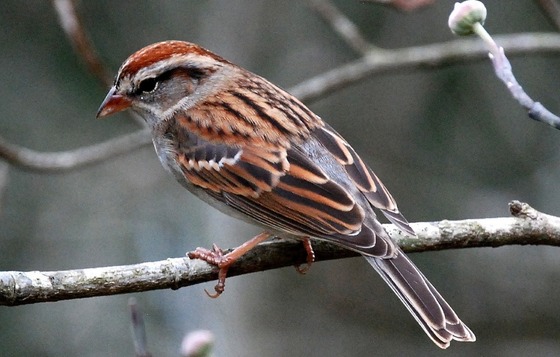 The underappreciated chipping sparrow (Terry W. Johnson)
By TERRY W. JOHNSON
The chipping sparrow is one of the birds that is likely to visit my feeders throughout the year. If you live north of the Fall Line, this may be the case in your backyard, too. If you live in south Georgia, more than likely you see chipping sparrows primarily in the fall and winter.
Although practically everyone in the state sees chipping sparrows at some time, most do not know its name. Many simply call it a sparrow.
This is unfortunate because this unassuming bird is both a fascinating and valuable backyard neighbor. …
Did you know chipping sparrows will sing up to 330 times an hour? Read Terry’s column for more surprises.
Terry W. Johnson is a retired DNR wildlife program manager and executive director of TERN, the Wildlife Conservation Section’s friends group. Read more columns, Terry's backyard wildlife blog and his book “A Journey of Discovery: Monroe County Outdoors.” (Permission is required to reprint this column.)
Top
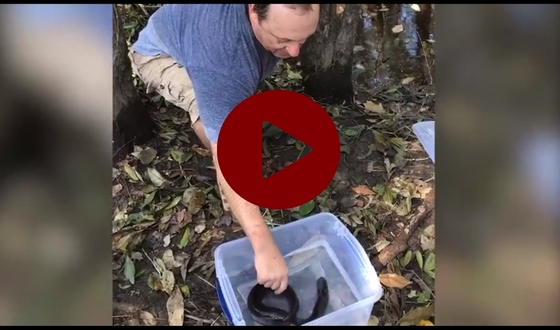 Eastern hellbenders are often called North America’s largest salamander.
But if you define largest as longest, two-toed amphiumas – which can reach almost 4 feet long compared to hellbenders at 29 inches – win hands, or toes, down.
Amphiumas (pronounced like this) are strange-looking amphibians with eel-like bodies, four tiny limbs, a lineage dating to the late Cretaceous and a love for swamp muck. “They are a true swamp animal,” naturalist Dirk J. Stevenson says.
Stevenson, of Altamaha Environmental Consulting (“Monster snappers,” Sept. 25), caught two two-toed amphiumas while doing DNR surveys for reptiles and amphibians at Alligator Creek Wildlife Management Area last week. Watch!
Two- and one-toed amphiumas – the only other species is the three-toed – are found in Georgia. The two-toed is the largest and most common, living in aquatic and wetland habitats throughout the Coastal Plain and in parts of the Piedmont just north of the Fall Line, according to Amphibians and Reptiles of Georgia.
Two-toed amphiumas feed mainly at night, eating everything from snails and crayfish to frogs and snakes. Stevenson tells of a biologist finding one that disgorged a 16-inch glossy crayfish snake. (In turn, mud snakes specialize in preying on amphiumas.)
Because of their cryptic ways and seldom-visited habitats, amphiumas "swim under the radar," Stevenson said. Yet they are “a very important component of freshwater systems.”
The lateral line system is easily seen on this two-toed amphiuma. (Dirk J. Stevenson)
ABOUT AMPHIUMAS
- Sometimes called ditch eels or Congo eels (although eels are fish).
- Occasionally confused with greater sirens, which have bushy external gills and front but not hind limbs.
- Have pores on their sides that mark a lateral line system used to sense vibrations and likely detect prey.
- Usually breathe by gulping air at the water’s surface.
- Although rarely aggressive can inflict a significant bite if handled carelessly.
Top
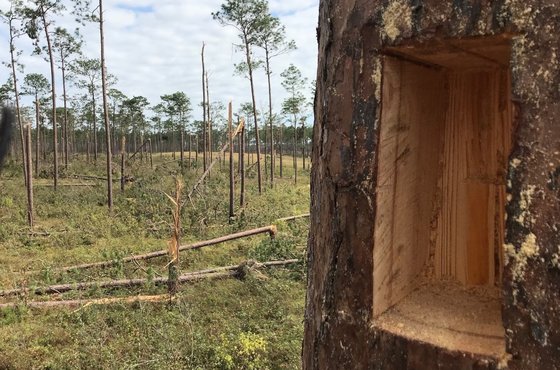 A Silver Lake pine prepped for a nest insert (Joe Burnam/DNR)
DNR has been helping south Georgians recover from Hurricane Michael. As that effort continues, some also are assessing how rare wildlife in the region fared. For example, Silver Lake Wildlife Management Area near Bainbridge lost about half of its pines that had nest cavities for endangered red-cockaded woodpeckers. The good news: Work has begun to add cavities, with 74 installed last week. (Also read this U.S. Fish and Wildlife Service post, "Survivors of the storm.")
Curious about amendment 1? The Georgia Wildlife Federation and Georgia Hunting & Fishing Federation recently offered their opinions on the Georgia Outdoor Stewardship Amendment, which would devote an estimated $20 million a year in taxes already collected on outdoor sporting goods to protect Georgia lands and water. (Also see WTOC's "What is the Outdoor Stewardship Amendment?")
Teachers and students statewide can explore Georgia’s wildlife and students’ artistic interests through the 29th annual Give Wildlife a Chance Poster Contest. This year’s competition for grades K-5 emphasizes pollinators and how they help produce food for wildlife and people.
Top
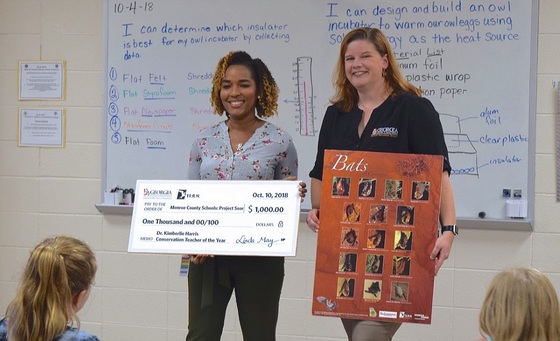 Dr. Kimberlie Harris, left, is recognized by DNR's Linda May. (Valerie Mercer/Monroe County Schools)
A Monroe County teacher’s proposal to create a habitat for bats will be helped by $1,000 from DNR and The Environmental Resources Network, friends group of the DNR Wildlife Conservation Section. In awarding Dr. Kimberlie Harris of Monroe County Schools this year’s Conservation Teacher of the Year grant, DNR environmental outreach coordinator Linda May said the “cross-curricular creativity, student-driven learning and community partners made Dr. Harris’ well-written proposal stand out.”
Eastern black rails, a small, secretive marsh bird, are proposed for listing as threatened under the Endangered Species Act, with the U.S. Fish and Wildlife Service citing declines of up to 90 percent in some Atlantic Coast populations. Over the past two years, surveys organized by DNR checked hundreds of sites in south Georgia but did not document any black rails.
The Atlantic pigtoe, a freshwater mussel native to waters from Virginia to Georgia, also is proposed for federal listing as threatened. The Fish and Wildlife Service’s related proposal to designate critical habitat excludes South Carolina and Georgia -- the species was last collected here in 1991.
Rare Radford’s mint appears on the upswing at Townsend Wildlife Management Area. Annual monitoring keyed to the careful removal of an overstory of invasive sand pines counted nearly 4,000 plants on the WMA this fall, stemming a decline at the site for a plant known worldwide only from McIntosh County.
Top
 Wildlife Conservation Program Manager Jason Lee talks sea turtles at CoastFest. (Linda May/DNR)
CoastFest drew an estimated 9,400 people to Brunswick’s Mary Ross Waterfront Park Oct. 6. The annual celebration centered on wildlife and conservation was moved this year from DNR’s coastal headquarters to the downtown park to better accommodate the crowds.
Youth ages 8-16 with an interest in birds are invited to the Youth Christmas Bird Count Dec. 8 at Charlie Elliott Wildlife Center. While traditional Christmas bird counts run eight hours long, this one is for birding newbies and others, at only two-and-half hours, expert-led and featuring lunch, field guides and binoculars.
A draft black bear management plan is the focus of an Oct. 30 public meeting in Waycross and open for comment until Nov. 5. The long-term strategy, also reviewed at meetings in Perry and Young Harris this month, is aimed at conserving black bears while providing sustainable harvest, promoting the species and minimizing human-bear conflicts.
You have never seen a hellbender photograph like this one by David Herasimtschuk, named a 2018 Wildlife Photographer of the Year winner by the National History Museum. Shot in Tennessee’s Tellico River, the image captures a hellbender catching a northern water snake.
Names in the news: The DNR Wildlife Resources Division has named wildlife biologist Emily Rushton the statewide turkey project leader. Rushton has worked as a private lands biologist for the division since 2013 and as a Florida Fish and Wildlife Conservation Commission biologist the previous five years. Atlanta Audubon Society landed a $50,000 grant from the Disney Conservation Fund for Project Safe Flight Atlanta. The grant, the chapter’s second grant from the fund, will help Atlanta Audubon “expand Project Safe and work with local stakeholders to implement solutions to reduce the number of resident and migratory birds killed by building collisions,” Atlanta Audubon Executive Director Nikki Belmonte said.
COMING UP
Nov. 2-4 – Becoming an Outdoors Woman Workshop, Charlie Elliott Wildlife Center, Mansfield
Dec. 11 – Feral swine workshop and trapping demo, 9 a.m.-1 p.m., Pierce County Ag Services Building, Blackshear. Register. Other workshops: Dec. 18 (Dawsonville), Jan. 7 (Quitman), Jan. 29 (Hawkinsville).
Jan. 26 – Flatwoods Fire and Nature Festival, 10 a.m.-3 p.m., Austin Cary Memorial Forest, Gainesville, Fla.
Feb. 15-16 – 2019 Weekend for Wildlife (DNR wildlife conservation fundraiser), Sea Island
WHAT YOU MISSED …
In the last Georgia Wild:
- Dark rivers, big turtles
- Add water for backyard wildlife
- Sea turtle nesting slows, recovery continues
Top
"Conservation funding in Georgia an easy choice," SaportaReport
"Bama bears kin to Georgia population," Rome News-Tribune
"Sea=level rise imperils wildlife, historical, cultural artifacts," U.S. Fish and Wildlife Service
"Georgia’s owl diversity increases in fall," Atlanta Journal-Constitution
"Can solar energy and wildlife coexist?" The Washington Post
"Solar zoning guide offers Georgia towns, counties model," Energy News Network
"Retiring Georgia parks director got start in DeKalb," SaportaReport
"‘Hyperalarming’ study shows massive insect loss," The Washington Post
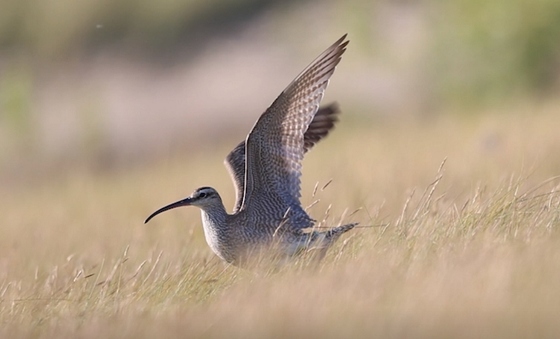 Whimbrels are one of the species tracked in "Great Migrations." (GPB)
VIDEO
"Great migrations," Georgia Outdoors (Georgia Public Broadcasting)
"Gopher frog conservation," The Amphibian Foundation
"Berry College eagle update," Berry College
"Autumn is great time to trout fish," DNR, shared by U.S. Forest Service
"Top leaf-viewing spots in Georgia," DNR State Parks & Historic Sites
"Manatee greets anglers at Tybee pier," WSAV-TV (Savannah)
Top
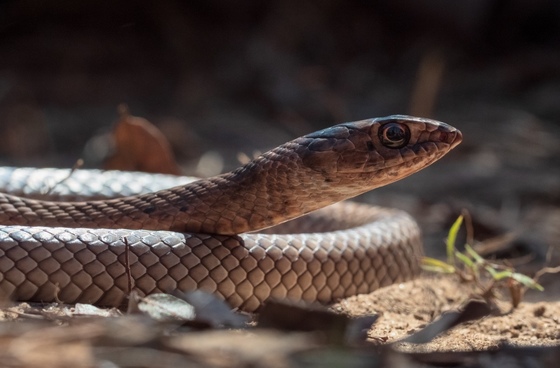 Coachwhip (Ian Garrison/Orianne Society member)
A two-day search for amphibians and reptiles on a south Georgia wildlife management area turned up some cool creatures this month. Nine amphibian and 13 reptile species (including the coachwhip above) were documented during the Places You’ve Never Herped event held by The Orianne Society. Highlights included a large greater siren, loggerhead musk turtles and a group of young alligators, writes Houston Chandler, species coordinator for Orianne's Longleaf Savannas Initiative. Chandler says the “bio-blitzes” help survey large sites for animals that often aren’t well documented and through time in the field raises awareness of the nonprofit’s conservation work with rare reptiles, amphibians and habitats.
CREDITS
Masthead: two-toed amphiuma (Dirk J. Stevenson)
Brazilian free-tailed bat in flight (J. Scott Altenback)
Top
|